- File manager for Mac
- Finder alternative: the list of best file managers for Mac
Finder alternative: the list of best file managers for Mac
In the process of work, many small tasks for working with files arise, from banal copying/moving to more complex ones, such as group renaming, updating archives, and creating backups on remote servers. Taking into account all the user-friendliness of Finder, doing all these operations quickly and efficiently is quite difficult, nevertheless not impossible, but rather time-consuming.
What is Finder on Mac?
Finder is the default file manager used on macOS that gives you access to files, folders and apps on Mac. It’s actually your guide to the Mac file system. Not only can you view and manage files and other items via Finder, you can also connect to servers, share instantly via AirDrop, back up your iPhone or iPad, and transfer files between your devices.
However, it doesn’t have tabbed browsing and is slow at times. There are many Finder alternatives out there today, and some offer even more. If you are looking for such a solution, keep reading to find a better Finder for Mac.
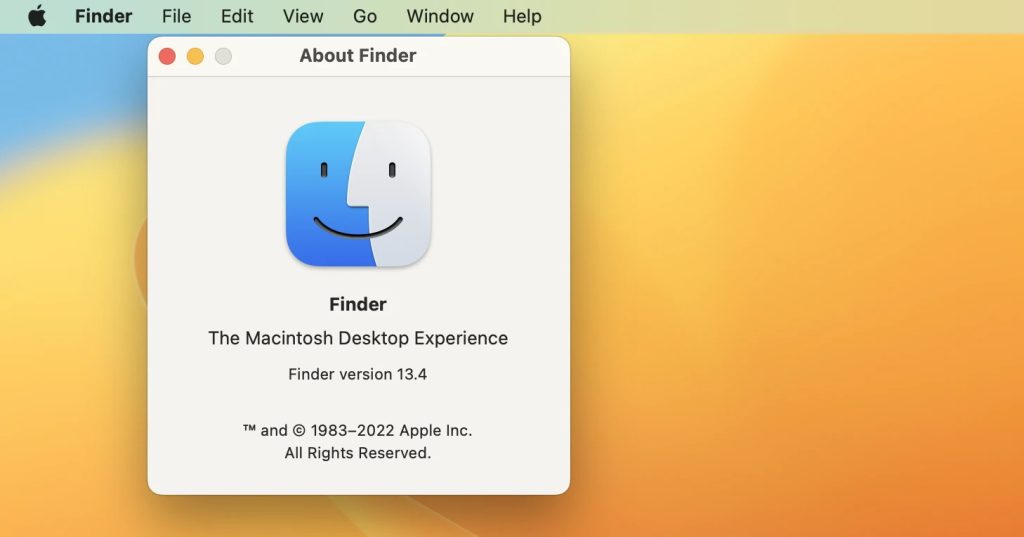
Top features:
- Advanced search to narrow your search results
- Finder tags
- Sorting and arrangement of elements
- Desktop stacks for convenient file organization
Overview of best Finder replacement software
Commander One
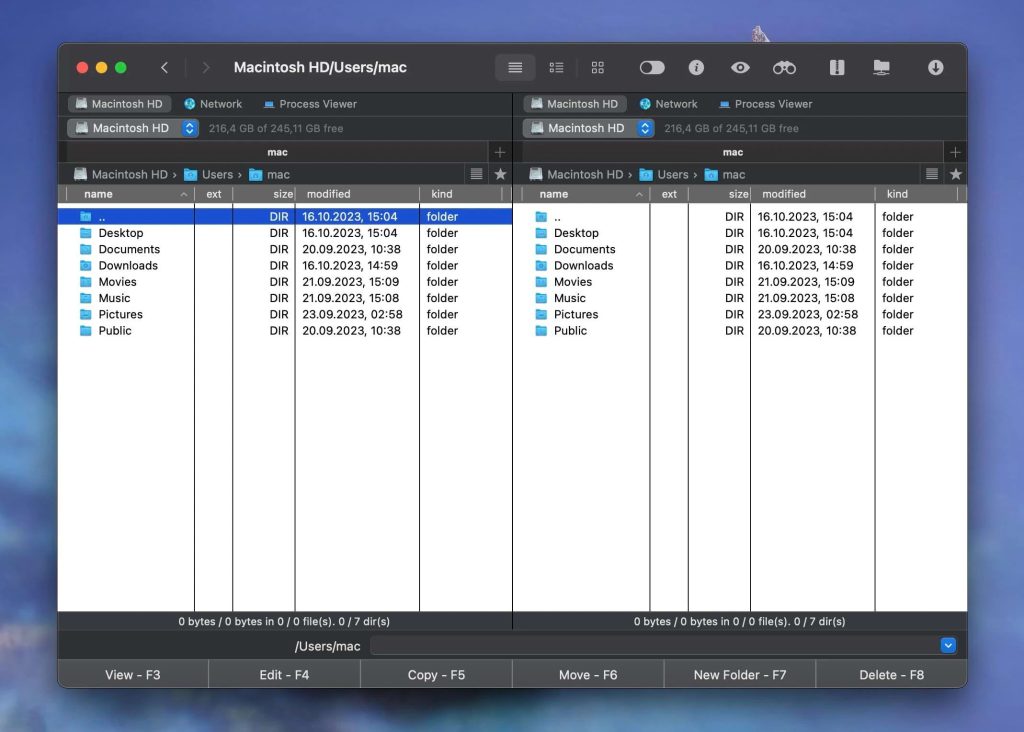
The first alternative to Mac Finder is Commander One. Having dual interface the app combines several protocols in one window making it very convenient for further use. If you are tired of many open windows, Commander One is one of the best Mac solutions. Convenient file navigator and client for working with protocols (FTP/SFTP/FTPS, WebDAV), cloud services (Backblaze, Box, Amazon S3, Google Drive, Dropbox, OneDrive, etc).
It showed itself excellently when working with files on Mac OS and when transferring data via remote access. Excellent additions to file manager are archiver, task manager, Terminal emulator, and much more.
Top features:
- Dual-panel interface with drag and drop controls
- Toolbar to show hidden files
- Comes with a brief mode
- Advanced search with support for regular expressions
- Customizable hotkeys
- Work with archives: ZIP, RAR, TBZ, etc.
Price: free, PRO edition priced at $34.99
Latest update: 25 Sep, 2023
Pros
- Ability to work with Android, MTP and iOS devices
- Terminal emulator
- Supports Finder tags
- A large list of supported archive formats
- Move files between local and cloud drive easily
Cons
- No single-pane view
- No synchronize directories feature
Path Finder
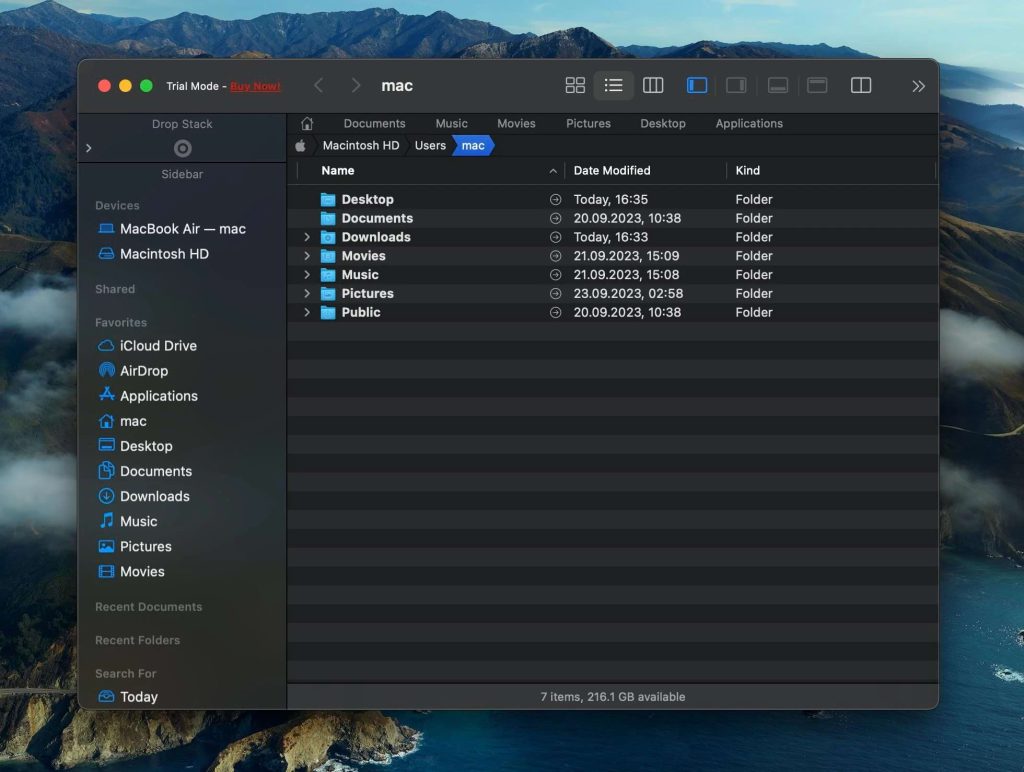
For those who lack Finder capabilities, Path Finder will certainly be a very useful program. This file management software follows the Finder ideology, significantly expanding its capabilities.
The program has a built-in FTP client, can replace the built-in Finder, works with tabs and bookmarks, can preview a large number of graphic and text files, manage processes, work with archives, change the appearance and properties of folders, install and uninstall applications, change combinations hotkeys, create and convert CD/DVD/Blueray images, etc. disks and much more.
Top features:
- Dropbox integration
- Has the built-in Comparison and Synchronization tool
- View files and perform file operations on iOS devices connected via USB
- Dual-pane browser to copy files
- Temporary stack
- Smart sorting
Price: $29.95 for yearly subscription, $32.95 for the 1-year license, 30-day free trial
Latest update: Jun 19, 2023
Pros
- A wide range of interface settings
- Optical disc recording function
- The ability to create a new file with a mouse click
- Built-in mechanism Allume StuffIt
Cons
- Overloaded with functions. Some of them are repeated in different places in the program, others duplicate functions of the built-in macOS utilities or are of dubious usefulness
ForkLift
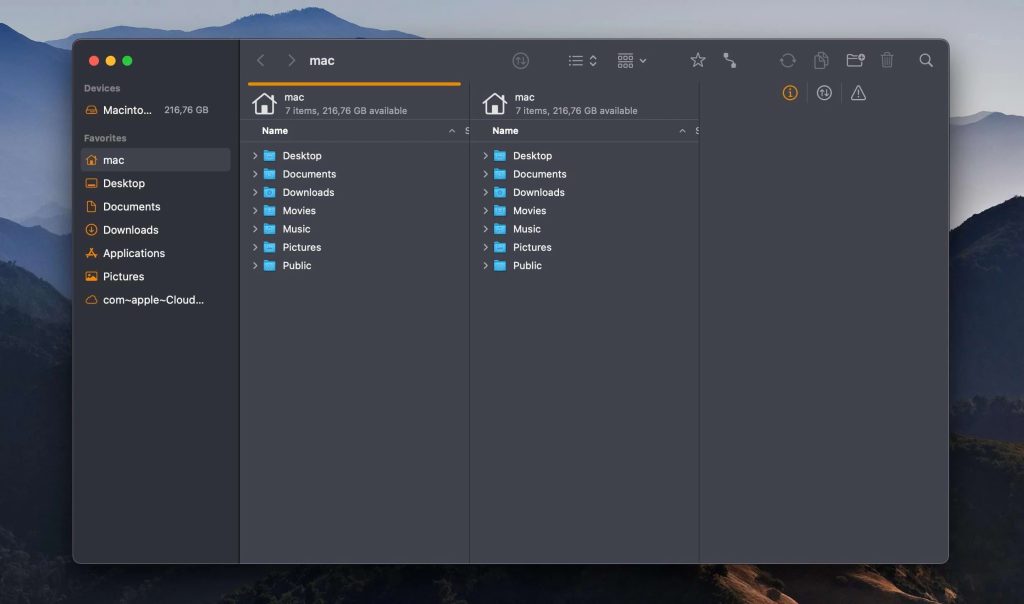
ForkLift strictly follows Apple’s requirements for interface design and attentive to details to the fullest. ForkLift is designed to be the fastest and most powerful Mac Finder alternative. The app turned out to be very pleasant, unloaded, and, most importantly, intuitive during navigation. Connect to FTP or SFTP servers, manage your Amazon account or mobile devices via Bluetooth.
All of these features are beautifully integrated into a sophisticated yet easy-to-use interface. The dual-panel design will dramatically increase your productivity along with modern features such as live preview, folder loading, etc.
Top features:
- Edit remote files
- A menu bar widget that runs in the background
- One-click sync
- Multi file renaming
- Archive management
Price: free trial, $19.95 for the Single-user License, $29.95 for the Family License
Latest update: Nov 17, 2023
Pros
- Dual-panel interface
- Synchronization of folders
- Batch renaming
Cons
- Cannot completely be controlled by keyboard
- More Terminal integration could be a plus
Fman

Fman is a two-pane file manager that displays the content of two different directories and just by using the Tab key you can quickly switch between panels. You can use fman to view directory contents, copy and move files/directories, mount external drives, and so on. This Mac Finder alternative works quickly and has an intuitive interface you will get aesthetic pleasure from working with.
The program’s functionality can be extended using plugins created by third-party developers. A large number of plugins for fman are available, including those for working with zip and tarball archives, a more informative status bar, getting detailed information about file properties, and so on.
Top features:
- Dual-pane interface
- Search suggests the most frequently visited folders
- The ability to tailor the application to your needs with a plugin system
Price: €39
Pros
- Ability to add extensions
- Simple to use
- Cross-platform
Cons
- A bit slow to load and scroll through folders
- No choice between dull-dark or fresh-light
Nimble Commander
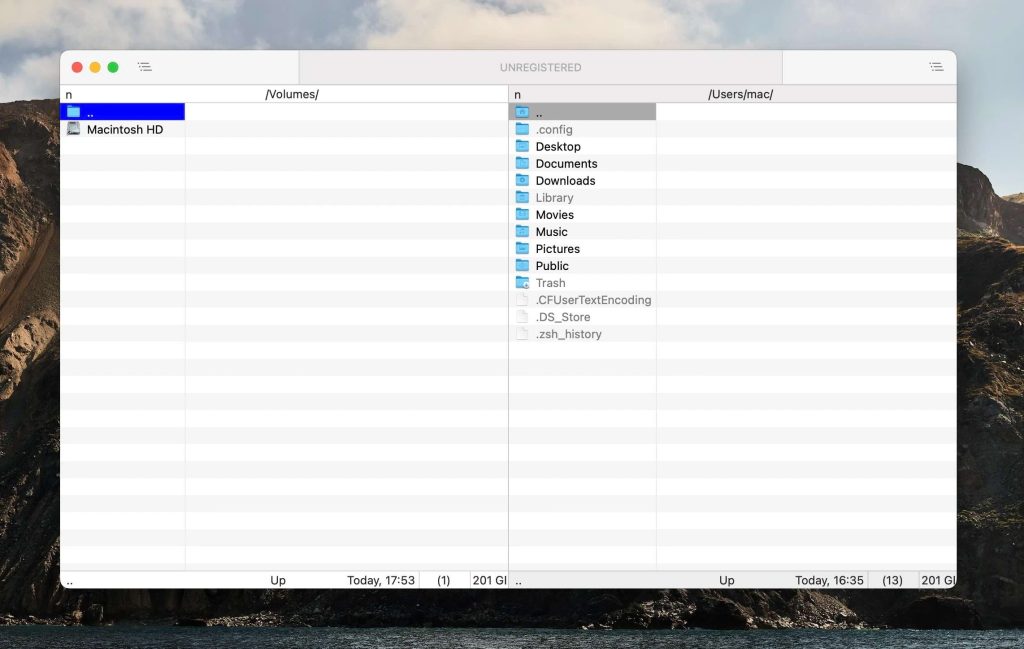
Nimble Commander – consumes a minimum amount of resources and provides instant response, working equally quickly with one window and dozens of them. The flexibility of this macOS Finder alternative plays an important role, as thanks to which you can customize everything according to your wish.
Almost any (if not all) actions with files and additional tools are performed by using hotkeys, which is a great time saver and allows you to work as in the good old days. The developers did not try to please everyone at once but clearly focused on the target audience – advanced users.
Top features:
- Admin mode
- Mass file renaming
- Browse archive files
- Built-in file viewer
- View system info like CPU/RAM usage, free disk space
Price: free trial, $29.99 on the App Store
Latest update: Dec 18, 2023
Pros
- Convenient navigation
- Integration with Quick Look
- Integration with Spotlight
- Terminal emulator
Cons
- Savvy users oriented
- Can have problems with opening a link to network folders
DCommander
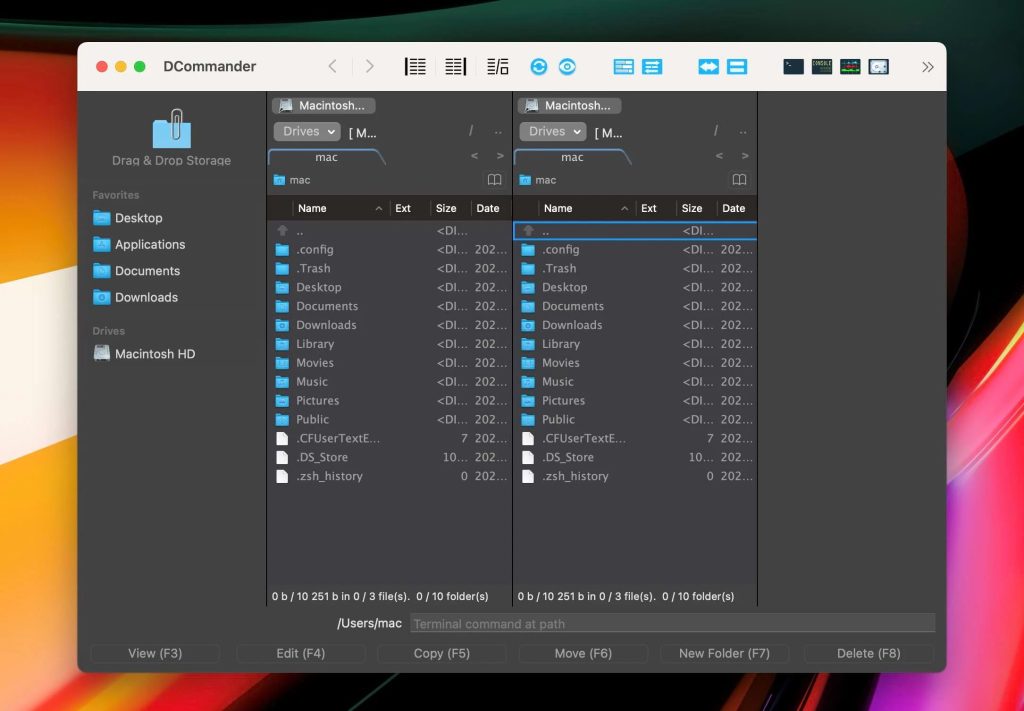
In general, DCommander knows its business and perfectly performs the tasks assigned to it. The interface of this Mac Finder replacement is practically no different from that in Total Commander: in the upper part there is a customizable toolbar, then there are two working windows with the ability to quickly select disks and information about the available space, and at the bottom, there is a panel with buttons for working on files.
Among the additional features, it is worth noting competent sorting, quick access to hidden files and folders, FTP support, reading, and working with archives (ZIP, JAR, EAR, WAR, XPI, and ODT) and tabs.
Top features:
- Built-in QuickLook functionality
- Navigate via keyboard
- Work with archives
- Advanced search tool
Price: free 30-day trial version, $39.99 for premium
Latest update: Aug 2, 2016
Pros
- Has a full-screen mode with supports Retina displays
- Quick viewing and editing at the click of a button
- Connecting to FTP servers, and more
Cons
- The functionality is not enough for advanced users
Why do people look for Mac Finder alternative?
The Finder app is often one of the main points of mockery when comparing macOS with Windows or Linux. In brief, it doesn’t have tab navigation, doesn’t provide a painless way to cut files. It is bitterly slow at times, and for even the most hardcore users navigating its eleven billion open windows when searching through complex projects and subfolders can be confusing. In addition to that, it creates .DS_Store files all over the place and in every folder you open so there is no reason to think of it as a good application.
Despite that, Finder is a satisfactory file management software. For an ordinary working routine, it works smoothly and you do not need to pay for its features. However, if you keep a lot of files and need to have proper organizing of the data, here things can be a bit challenging.

So what is missing in Finder and why do people need Mac Finder replacement?
- Apple hasn’t always updated Finder with features on a regular basis. If to compare Finder with some older versions of other file management software, the lack of Finder functionality can be a major hurdle.
- One of the features missing in Finder is an Advanced Search. Sometimes it can be difficult to find the file/folder you are up for.
- Finder viewing options are limited. When you want to browse through hundreds of photos and choose the right ones, it can be a real nightmare.
- Finder is not the great choice to manage your network storage. Quite often you would wish you had a better solution.
- Some of the basic features are performed very poorly not even taking into consideration that it lacks some of them (such as remote connections, syncing or intuitive navigation).
What features should have a good alternative to Mac Finder?
Let’s try to figure out what features should an efficient Finder alternative have? Or what to look for in its alternative.
- The user interface of the file management software should be rather intuitive. Users do not need to spend hours in front of the computer screen learning how to work with this utility. In brief, the no-learning scenario is the best one.
- Another key factor is customizability. It should cover every aspect of the app, especially viewing options. In an ideal scenario, you should have the right way to find the files/folders you want.
- Additional features are also a great plus for a good Finder replacement, such as batch renaming, synchronization of files and folders, network file management, etc.
- Dual-panel interface. The most convenient and easy way to work with your data. It can help you to compare information from the single pane.
- Reliability is what we always keep in mind, but never talk about. As you are dealing with the important files and you are searching for an app to work with them, reliability should be an issue of your concern in order to avoid any bugs and data damage.
Having all these criteria in mind, we have gathered the top Mac Finder alternative solutions. Have a look at our solutions below and choose the one that appeals to you.
Conclusion
Here is our list of best Mac Finder alternative solutions, however, you can look for other Finder replacements. Perhaps someday Apple will think about updating the Finder making it one of the best file managers but for now, we recommend you take a closer look at Commander One or similar software and find the most appealing to you. All the solutions from our list combine convenience and advanced functionality.
Frequently Asked Questions
If you’re using a Mac and looking for a better file manager than the standard Finder, consider checking out Commander One. This powerful tool offers handy features such as dual-pane views, customizable hotkeys, and FTP support, among others. Its easy-to-use interface makes it a great option for anyone who wants to enhance their file management experience on macOS.
MacOS has its own file manager – Finder, which is largely similar to File Explorer (and better in some regards).
The lack of Finder functionality makes it difficult for users to fully control their data.
